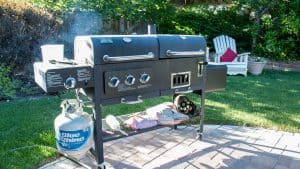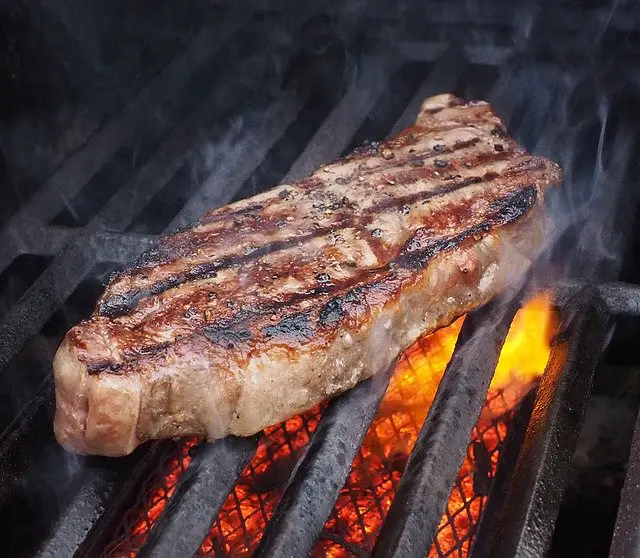
It’s just standard to accompany an outdoor entertainment area with an awning that would protect your guests from the summer sun, rain, or snow. If you don’t have an awning installed yet, it probably hit you just recently after visiting a friend that you need some protection from the sun when barbecuing in your backyard. Maybe you are tired of barbecuing under an umbrella – the greasy handle and flaws that come with vinyl umbrellas are a turn off – that you are finally out for a more permanent solution.
Can you even grill under an awning? Absolutely yes you can, but, as you can imagine, there are several things you need to get right. If the awning is made of vinyl and installed at a low height, you probably shouldn’t grill under it in that state. Then there is the issue of the design of your deck – is it a screened-in deck? Such decks may create a dangerous environment if your grilling involves flare-ups.
The Risks Of Grilling Underneath An Awning
You should understand that the canopy of the awning, whether combustible or not, can be hazardous when exposed to heat for a long time. Just as it’s risky to grill under low branches of a tree, you should also bear in mind the potential risks with grilling under your awning.
- Most canopies are made from polyethylene or polyester which can melt or catch fire and burn down your entire manufactured home
- Partial burning of the canopy, which you might not notice instantly, can produce drops of molten material that may drop on your food or guests
- Metallic canopies tend to get hot when exposed to heat, so your guests might probably not have a nice time enjoying your grilled food under a metal canopy.
The damage inflicted by the smoke on the canopy is real. In the long run, you might end up with a darkened and unsightly awning that must be replaced. The replacement will need to be frequent sometimes.
How to Safely Grill Under Your Awning
Do Some Pre-Cooking
If your awning is made from combustible material and you aren’t in a position to upgrade to a noncombustible canopy yet, consider precooking your food before grilling it in the entertainment area to cut on the cooking time.
Awning Height
If your awning isn’t high enough (chances are it isn’t), consider increasing the height to prevent exposing the canopy to excess heat from below.
Depending on the kind of grill you have, the best height should be at least 6 feet from the grilling surface.
Awning Material
Install an awning made from fire-resistant material. Metal-based canopies may easily come into your mind but they are never a good option for this purpose as they don’t provide the best experience under any heat-intensive activity.
It would be wise to choose woven canopies that let much of the heat and smoke into the atmosphere without making you feel like you’re grilling under a bare sun.
Manufacturers use a wide variety of industrial plastics and fabrics that may give you a real headache deciding the most effective option for your needs. For that reason, do your research and simply ask your dealer to show you the best fire-resistant awnings in their store.
It would be prudent to select a canopy with a fire-resistance rating of NFPA 701 and CPAI 84.
Finding the best maker for your fire-resistant awning project is essential; especially when you want chemically treated fire-resistant fabrics.
Awnings made from Herculite’s Sure-Chek® fire barrier fabric comes with excellent anti-fire properties allowing you to grill under them without worrying about the positioning of your grill or long-term effects of the heat on the fabric.
Keep in mind that some of the fire-retarding chemicals such as PBDEs (Polybrominated diphenyl ethers) often added on awnings have safety concerns.
Grill Position
Think about the positioning of the grill under the awning. It is wise to place the grill as far away from the middle as possible. Placing it on the edge of the awning can be the right thing to do. This is to help the smoke escape the canopy easily.
In calm and windless conditions, be careful not to concentrate a lot of heat in one small area of the canopy. If the material is not resistant to heat, you might end up burning some parts of the canopy. Depending on how you choose to set up the grill, consider accompanying your grilling with a fan that will blow away excess heat.
Be Prepared
Have the appropriate firefighting equipment in place just in case a fire breaks out. However, these equipment can only be effective if you are confident or trained to handle small fires. If a response won’t be of any help, stay ready to call the fire department.
Ensure that the canopy is fixed firmly on the wall or supporting poles. Sometimes the heat waves tend to cause the canopy to fly off or knock over.
Go Smokeless?
Consider investing in a smokeless grilling machine. Consider taking measures to reduce the amount of smoke produced by the current barbecuing machine.
Weather Conditions
Weather conditions can be important. Windy conditions make open flames risky. Extreme dryness can be just as risky. If possible, consider shielding the grill from the wind by hanging a piece of fabric in the rear.
Keep a safe distance from the walls of your home. For you to grill in the awning means the grill will be in close proximity to the wall. But because the manufactured home may have wooden parts on the walls that make it flammable, consider positioning the grill a safe distance from the walls. You should even keep a longer distance if your grill is powered by propane or charcoal.
If your awning is not fire-resistant (probably because you didn’t envision grilling under it back then) and you can afford a new fire-resistant alternative, consider investing in a stand-alone fire-resistant fabric that can be added on the awning when grilling and removed afterward. One such fabric is Top Gun FR 776 Burgundy Fire-Retardant Awning and Shade Fabric.
Why You SHOULDN’T Grill Underneath Your Awning
The above was tongue-in-the-cheek support meant to guide you on how to grill in your awning. But, honestly, it isn’t entirely advisable to grill in your beautiful awning that cost you a lot of money to install.
Unless you want to grill in the middle of a rainstorm when grilling in the backyard wouldn’t be a particularly good idea, there is no good reason to grill in the awning. In fact, grilling in the open backyard offers a more fun experience compared to inside an awning.
Space is the first benefit
The open backyard is spacious than inside the awning. You have access to more sitting space for guests and family members. Better yet, if your grill is one of those that demand large spaces, grilling in an open space is fun than grilling in a small confined awning. You obviously need more space to accommodate food and other items that go with a full-blown party barbecue.
Open Air
Another benefit of grilling in the open backyard is a minimal smoke annoyance and almost no overheating. Unlike the awning that will trap smoke and heat under it, the open backyard readily lets smoke and excess heat escape into the environment.
Awning – Wear & Tear
Also, long term grilling under your awning takes a toll on the canopy of the awning and the walls of your home. In fact, there is a risk of burning down your home if, by any bad chance, the fire gets on the flammable parts of the wall (if it is made from wood or has wooden or vinyl sidings). The canopy itself may catch fire or melt and give a bad party experience.
So, there isn’t really a good reason as to why you might want to ruin your awning with the grilling heat and smoke. If you look at the cost of having a new awning in place after ruining the current one, or the cost of repairing the damages that may be caused by barbecuing under the awning, it should be enough to convince you to grill in your open backyard.
However, sometimes the risk isn’t that big. If you take all the necessary precautions and set up the grilling properly, there are minimal chances you will have a bad experience. Also, nothing beats the experience of grilling under the awning with family and friends.
Final thoughts
The canopy’s support for grilling is the last factor we consider when installing awnings. That’s why you might be asking yourself whether it is a good idea to barbecue under it. It is perfectly OK to grill under the awning most of the time, but need to consider several things including the material of construction of the awning.
Awnings made from fire-resistant materials are better because they won’t melt or catch fire above the grill’s heat. You should position your grill at the edge of the awning to permit smoke escape into the atmosphere. Also, keep a safe distance from the walls of the house. You can raise the height of the awning slightly to prevent the heat and smoke from building up.
You don’t really need to grill in your awning if you have an open backyard on your property except if it’s very necessary.


